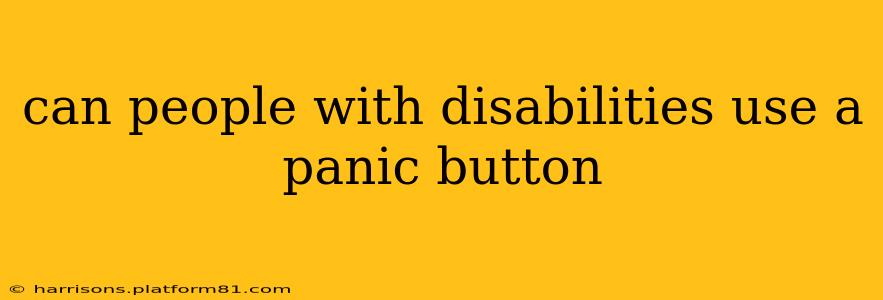Can People with Disabilities Use a Panic Button? Accessibility and Panic Button Technology
The short answer is: yes, but the level of accessibility varies greatly depending on the specific panic button system and the individual's disabilities. Many modern panic button systems are designed with accessibility in mind, but it's crucial to consider individual needs and choose a system that meets those requirements.
This article will explore the accessibility features of panic buttons and address common concerns regarding their usability for people with disabilities.
What types of disabilities might affect panic button use?
Several disabilities can potentially impact a person's ability to effectively use a panic button. These include:
- Visual impairments: Individuals who are blind or have low vision might struggle with buttons that lack tactile feedback or clear auditory cues.
- Motor impairments: People with limited dexterity, tremors, or paralysis may find it difficult to press a standard button.
- Cognitive impairments: Individuals with cognitive disabilities might not understand the purpose of the button or how to use it effectively.
- Hearing impairments: While many panic buttons have visual indicators, those relying solely on auditory alerts may not be suitable for people who are deaf or hard of hearing.
- Speech impairments: Some panic buttons incorporate voice communication, presenting challenges for individuals with speech difficulties.
What features make a panic button accessible?
Several features significantly enhance the accessibility of panic buttons for individuals with various disabilities:
- Large, tactile buttons: Buttons with a raised surface and clear text or braille markings are easier to locate and operate for visually impaired individuals and those with dexterity limitations.
- Auditory feedback: A clear audible confirmation after the button is pressed provides assurance for users and allows those with visual impairments to understand the system's response.
- Visual indicators: Bright flashing lights or clear visual signals indicate that the alarm has been triggered, beneficial for individuals who are deaf or hard of hearing.
- Voice activation: Hands-free operation through voice commands can be highly beneficial for people with motor impairments.
- Simple and intuitive design: A straightforward interface without unnecessary complexities is crucial for users with cognitive impairments.
- Customizable settings: The ability to adjust settings like volume and brightness allows users to tailor the system to their individual needs.
- Multiple activation methods: Offering alternative methods of triggering the alarm, such as a pendant or mobile app, increases accessibility for those with limited mobility.
Are there different types of panic buttons?
Yes, panic buttons come in various forms, each offering different levels of accessibility:
- Standalone buttons: These are simple, self-contained units, which may or may not have accessibility features.
- Integrated systems: These systems are part of a larger home security or medical alert network, often incorporating more advanced accessibility features.
- Mobile app-based panic buttons: These applications allow users to trigger an alarm through a smartphone, increasing accessibility for many individuals.
How can I ensure a panic button is accessible for someone with a disability?
Choosing the right panic button requires careful consideration of the individual's specific needs and abilities. Consult with occupational therapists, assistive technology specialists, or disability support organizations to determine the most suitable system. Consider a trial period to ensure the chosen system meets the user's needs comfortably and effectively. Furthermore, regular testing and maintenance are vital to guarantee the system's continued functionality and accessibility.
By understanding the various accessibility features available and considering the individual's specific requirements, it's possible to select and implement a panic button system that offers safety and peace of mind for everyone, regardless of their abilities.
